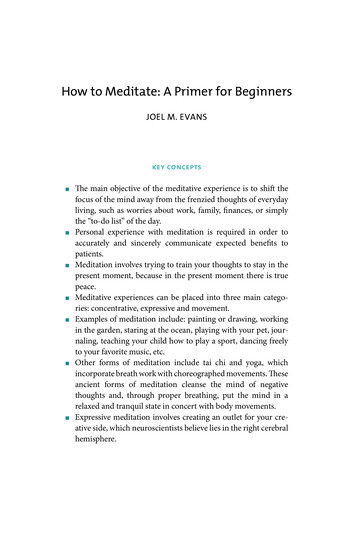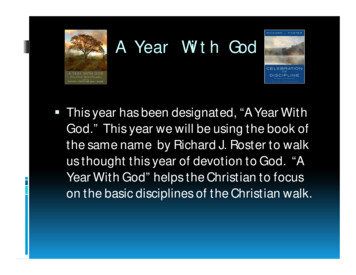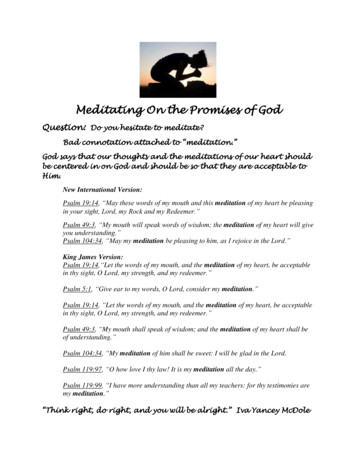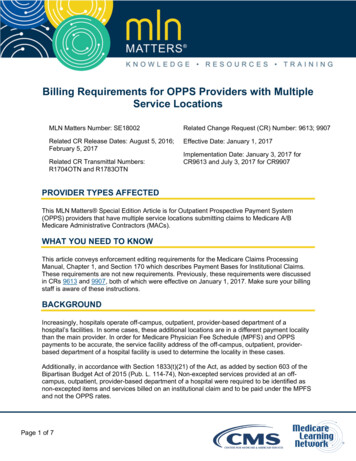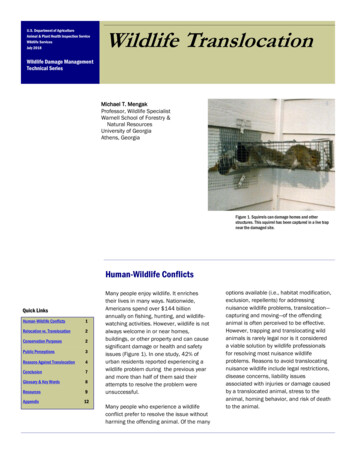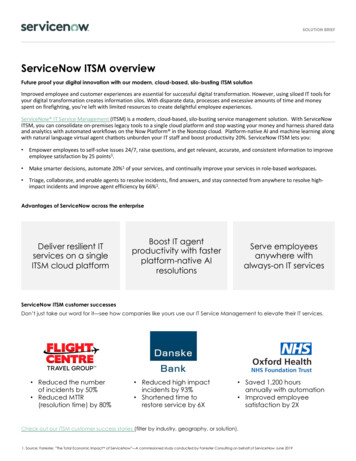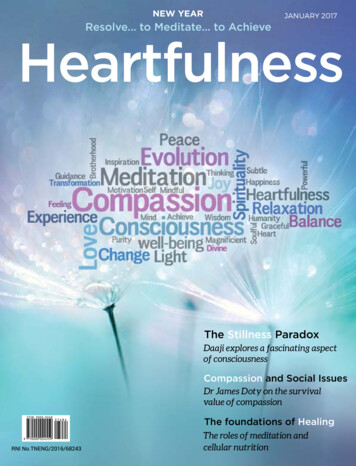
Transcription
NEW YEARResolve. to Meditate. to AchieveJANUARY 2017HeartfulnessThe Stillness ParadoxDaaji explores a fascinating aspectof consciousnessCompassion and Social IssuesDr James Doty on the survivalvalue of compassionThe foundations of HealingThe roles of meditation andcellular nutrition
Join us for 3 free online masterclasses in meditation,conducted by the teacher of Heartfulness, Kamlesh D. Patel.2, 3, 4 January 2017Times:The masterclasses will be available online each day, starting at midnight, and accessiblethroughout the day. Each class runs about 1 hour.Register:Heartfulness.org/masterclassor Facebook - Heartfulness masterclass02RELAX. EXPAND CONSCIOUSNESSIn the first class, learn the Heartfulness relaxation for physical wellbeing, as well as the Heartfulness guided meditation on the sourceof light within your own heart.03UNWIND. SIMPLIFYIn the second class, be guided through a simple rejuvenativetechnique to unwind the mind at the end of the day, to let go ofstresses and emotions, and simplify your life.04CONNECT. WITH YOUR INNER SELFIn the third class, learn to connect with your inner Self by listening tothe heart’s voice. Observe your deepest feelings, make wise choicesand weave your destiny.January 20173
Download FreeDigital Version for 12 months value 29.90RelaxationHEARTFULNESS MAGAZINESubscribe toHeartfulnessThrough meditation, calmSit comfortably and close your eyes very softly and very gently.Let’s begin with the toes. Wiggle your toes. Now feel them relax.Relax your ankles and feet. Feel energy move up from the earth up your feet to your kneesrelaxing the legs.Relax your thighs. The energy moves up your legs relaxing them.Now, deeply relax your hips stomach and waist.Relax your back. From the top to the bottom the entire back is relaxed.Relax your chest and shoulders. Feel your shoulders simply melting away Relax your upper arms. Relax each muscle in your forearms your hands right up to yourfingertips.Relax the neck muscles. Move your awareness up to your face. Relax the jaw mouth nose eyes earlobes facial muscles forehead all the way to the top of your head.Feel how your whole body is now completely relaxed.To order copies online single, 12 months subscription and24 months subscription please go to: mail: subscriptions@heartfulnessmagazine.comPrinted copies will be available at selected stores, airports and newsstands,and at Heartfulness Centers and Ashrams.4/practiceheartfulness/ Heartfulness/heartful ness/practiceheartfulnessHeartfulnessMove your attention to your heart. Rest there for a little while. Feel immersed in the love and lightin your heart.Remain still and quiet, and slowly become absorbed in yourself.Remain absorbed for as long as you want, until you feel ready to come out.To experience Heartfulness,please contact one of our trainers at heartspots.heartfulness.orgor via the website at www.heartfulness.orgToll free numbers: North America 1 844 879 4327 India 1 800 103 7726January 20175
42EMBRACINGChangeDear readers,3422INSIDE12 Between stimulus and response2919 When I was half asleep22 The science of appreciation24 Am I the victim40or am I victimizing?29 The stillness paradox34 An integrative foundationto healing40 The soul is the real healer42 The Buddha project53 Alkaline kale salad & pumpkin64bread with chia & herbs57 Green School: an inspiring source64 Lessons from the garden:gardening glovesAnother year has passed, and hopefully we are all another year wiser! Thefestive season has also passed – an important time of year in most culturesand religions, signifying the winter or summer solstice, as well as endings andnew beginnings. It can be a joyful time and also sad, probably both, dependingon circumstances. Certainly only the hard-hearted are immune to the feelingsand memories of family members who are not with us, as well as the delightsof family gatherings and celebrations, and young children’s enjoyment duringChristmas, Hannukah, Milad un-Nabi and Bodhi Day.The beginning of January is when we evaluate what has been, and resolve torealize our hopes and dreams for the coming year. It is a time for change. Thelist of New Year’s resolutions can be endless: lose weight, get fit, eat healthier,drink less, be more compassionate and accepting with our loved ones, workcolleagues and friends, spend more time with the people that matter, worksmarter, spend less and on it goes.What if there were some simple practices that would help us to embrace thesechanges naturally and easily? Well there are. The ancient art of meditation isdesigned to clear the mind, open the heart, and allow us to access our innerpotential, so that decision-making becomes effortless, and we learn how toembrace change. Woolly brain syndrome disappears. Confidence and courageradiate from the heart. It is not magic – work is required – but the results arethere for all those who wish to make the effort.If you would like to give yourselves a gift for the New Year, please join us fora series of three masterclasses in meditation on the 2, 3 and 4 January 2017,conducted by Kamlesh D. Patel (www.heartfulness.org/masterclass).And Happy New Year from all of us at Heartfulness Magazine.May 2017 be filled with peace, love and joy.The Editorial TeamFOR CHILDREN68 Painting stones70 The rainbow children196HeartfulnessJanuary 20177
CONTRIBUTORSCONTRIBUTIONSJames DotyNS NagarajaJames is the author ofInto The Magic Shop: ANeurosurgeon’s Quest toDiscover the Mysteries ofthe Brain and the Secrets ofthe Heart (Avery, 2016) andis co-founder of the Centerfor Compassion & AltruismResearch & Education (CCARE) atStanford University in Palo Alto, California,USA.NSN is founder and CEOat Sensei Technologies.He has been practicingHeartfulness meditationfor 20 years and isdeeply interested in thescience of spirituality,software architecture &design philosophies. He alsoworks with Brighter Minds to develop toolsand techniques to enhance cognitive skills,especially for children.letters to the editors and ://www.heartfulnessmagazine.com/subscriptionsISSN 2455-7684PRINTED BY:Sunil KumarKala Jyothi Process Pvt. Limited1-1-60/5, RT C Cross Roads, Musheerabad,EDITORIAL TEAMRishabh Kothari, Elizabeth Denley,Emma Ivaturi, Sylvie Berti-Rossi,Veronique NicolaiHyderabad-500 020, TelanganaVeronique DesvigneJosh BulrissPUBLISHER:Sunil Kumar representing Spiritual HierarchyPublication Trust on behalf of Sahaj MargDESIGN TEAMHelene Camilleri, Emma Ivaturi,Uma Maheswari, Nehal SinghPHOTOGRAPHYJosh BulrissARTBrigitte SmithWRITERSJosh Bulriss, Veronique Desvigne, AlandaGreene, Simonne Holm, Harpreet Kalra,Anne-Grethe Kousgaard, Nehha Lohiya, NSNagaraja, Kamlesh D. Patel, Brigitte Smith,Santa Telleri, Veena VermaIssue 15, January 20178HeartfulnessVeronique is a Montessoriteacher in internationalschools. Her focus nowis to develop BrighterMinds programs inEurope to give childrenthe opportunity toconnect with their intuitionand sense of observation,which are lacking in most modern education. Shefinds that the practice of Heartfulness has helpedher bring harmony into the classroom and bringup her own children joyfully.A passionate devotion tocapturing the core of culturehas driven this New Yorkphotographer to wanderthe world.Josh’s ultimate goal isto enhance his viewer’sawareness of the everydaybeauty that this world has to offer.He challenges his viewers to look deeperinto his images to capture the innermostsoul of his subjects. With a thread of innerpeace that emanates throughout his work,Josh holds just one mantra to his heart:“The world is my studio.”Spirituality Foundation, Chennai. 2015 Sahaj Marg Spirituality Foundation** Printing, publishing, distribution, sales,sponsorship and revenue collection rightsvests with the Publisher alone.All rights reserved. ‘Heartfulness’, ‘HeartfulnessRelaxation’, ‘Heartfulness Meditation’, ‘SahajMarg Spirituality Foundation’, ‘SMSF’, ‘www.Heartfulness.org’, the ‘Learn to Meditate’ logo,the ‘Heartfulness’ logo are registered ServiceMarks and/or Trademarks of Sahaj MargSpirituality Foundation. No part of thismagazine may be reproduced in any form orby any means without prior written permissionfrom the Publisher.The views expressed in the contributions inthis publication do not always reflect those ofthe editors, the Heartfulness Institute, or theSahaj Marg Spirituality Foundation.January 20179
How will you achieve them?Relax when stressedMeditate to expand consciousnessand regulate thoughtstheRejuvenate the mind at the end ofeach day to release heavinessNew YearConnect with your own sourcebefore sleeping to wake refreshedExercise regularlyEat simple, natural foodWhat changes will you make in the New Year?Here are the most popular New Year’sResolutions we gathered from our readers:10HeartfulnessFitnessPositive thoughtsLose weightHappinessHealthy foodInner calmNatural sleep patternsRealize goalsGo to bed early to be in tune withnatural cyclesRemember your goals and focusattention on themTreat others with great kindnessAccept whatever life bringsyou graciously, with a cheerfuldispositionBe grateful for everythingcJanuary 201711
}Q & A }Between Stimulusand response- PART 2 -In conversation withDr James R DotyJDAnother one of those is this inherent desireto be tribal in nature, and again, there isan evolutionary reason. We talked about huntergatherer tribes as our primary survival strategyand we know that people tend to gather orconnect with others who look like them, act likethem and share the same socio-economic status,culture, religion and color. Why? When you arewith people who are like you, what happens? Yoursense of fear, anxiety or threat diminishes. in the context of ourmodern global society;the reality is that whathappens in one part ofthe world can profoundlyIn Part 1, DR DOTY explored the evolutionaryadvantage of compassion in human beings andits relationship with our physiological responses. InPart 2, he takes us further into aspects of humanbehavior that relate to compassion and collectivesocial issues.INTERVIEWED BY JOHN MALKIN, AUGUST 201612HeartfulnessThe problem is that this type of interaction can actas an echo chamber to reinforce negative behavioror a perception of fear or threat, which results inyou being closed to the opinions of other peopleand groups. Or you may feel a desire to eliminatethem because of this false notion that they aregoing to threaten your existence. It is often a selffulfilling prophecy. This is a natural state of being,unfortunately; we know that it can be activatedand we have seen this happen. You alluded tothe political environment, where you see groupsstoking fear and anxiety to engage this primitivepart of us that responds to fear or threat. Thisresults in individuals identifying with groups thatthink or act like them in the false notion that thisis protecting them.Politicians and others have used this reality fortheir own purposes for millennia. The problem isthat it is not a long-term survival strategy, and it isaffect another part of theworld.certainly not a long-term solution in the context ofour modern global society; the reality is that whathappens in one part of the world can profoundlyaffect another part of the world. We are no longerin this position of small hunter-gatherer tribeswhere we can engage in conflict in small areas andhave no big effect on the rest of the world.Frankly, our survival demands that we gain selfawareness of these issues. We need to understandthis reality and also that, in fact, there areresources for all. If we change our behavior,look into ourselves, and understand the negativeJanuary 201713
Technology and digitaltechnologies have had avery profound positiveaffect in many domainsand allow us to live as wedo today. That being said,what we do know is thatwe feed? How many buildings could we build? Howmany people could we educate? This ultimately hasto be the paradigm as we look toward the future.QI am curious about the effect digitaltechnology is having on human compassion. Iam reading in studies that as people are lookingat screens so much and interacting with machinesmore and more, they have a diminished capacityfor empathy and more difficulty reading facialand emotional cues from others and recognizingtheir own emotions. What is your sense of howthe new digital technologies are affecting humancompassion?for some individuals, as youpoint out, these types oftechnologies do not trulycreate a connection withothers.attributes that we have, and our biases towardothers – we call these cognitive biases – it canactually lead to a society that works for everyone’sbenefit, in which we care for those who look andact like us, our tribe if you will, and also care forothers outside our close-knit group.As an example, if we took one week’s worth of themonies spent every year on military technology,we could provide education for tens of millionsof children from kindergarten to year 12. Andthat is just one week. Imagine what we could doif we markedly decreased expenditure on militarytechnology and armies! How many people could14HeartfulnessJDThis is a two-edged sword. Technology anddigital technologies have had a very profoundpositive affect in many domains and allow us tolive as we do today. That being said, what we doknow is that for some individuals, as you point out,these types of technologies do not truly create aconnection with others. It is a reality that we as aspecies are profoundly social and when we do notconnect with others we are lonely.As an example, in the United States one quarterof people when they are suffering, hurt or are inpain, feel that they have no one to share that withor be comforted by. Also remember that we havean epidemic in the West of loneliness, isolation,anxiety, stress and depression. You simply haveto look at whether it is digital technologies ormodernity in regard to what has happened.Two to three hundred years ago we lived in multigenerational environments and most people grewup in one part of the country. Often times theirparents, grandparents, siblings and children alllived in close proximity, if not the same building.They stayed in the same place for the entire lengthof their life and as a result each individual knew thatthey were part of a community and that communitycared for and nurtured them. It accepted them forthe good parts of themselves and also the bad partsand still loved them.In modern society many of us do not have thattype of environment. When growing up we oftentimes move from city to city, so there is no stabilityand acceptance in the interactions we have withothers. As we become adults we move away togo to college and then have a job where we areseparated from siblings and parents. We go toplaces where we know no one. And that createsan environment for many people of loneliness,despair and anxiety. When we include then theeffects of digital technology, which can make thiseven worse, it can have a profound negative affect.January 201715
We also know that when a person is lonely oranxious this leads often times to rumination andmakes the situation worse.That being said, we also know that there are certaindigital or artificial technologies that can have apositive benefit. Some of these are technologiesthat allow us to connect with people who are likeus and share our interests, which is wonderful.Robots are being used to interact with peoplewho are lonely or elderly and can potentially evenperform aged care, if you will. There is evidencethat we can develop a positive relationship withthese artificial entities. But these artificial entitiesare artificial entities. They will never replace ahuman, even though in certain contexts they canbe beneficial. So, it is a two-edged sword.As we see the evolution of artificial intelligence andmachine learning, this leads into another potentiallyvery difficult issue, because who is behind all this?Who are the manipulators? If we examine theissues of free will, we appreciate that many of theactions we engage in are related to environmentalcues on a subconscious level. We also understandnow that we can be manipulated. And when thereare terabytes of data on how individuals move, andwe have the ability to collect and analyze immenseamounts of information about an individual, itpotentially means that the subconscious cues canbe manipulated in very negative ways. These mayhave no negative effect on the savannah in Africa – infact they were part of our survival mechanism – butin a modern environment we can be manipulated bya small group.In some ways it is already happening; there is awhole field called Neuromarketing, which takesadvantage of our biases and utilizes this knowledgeto motivate us or manipulate us to buy things or docertain actions for the benefit of others. This hasto be kept in mind, because if there are no safetychecks it will lead to a small group of people beingable to manipulate large segments of our society.QI am very interested and concerned aboutwhat you are talking about. It’s remarkablethat there is worldwide warrantless surveillanceby governments and corporations collecting dataand keeping track of people. It is well beyondwhat George Orwell imagined. It seems peopledon’t quite realize this is going on. With so muchinformation generally, people seem overwhelmedand interested in one topic for an hour and thensomething else happens and they move on to thenext item.JDThat is probably a discussion we couldengage in for a long time.To be continuedDr Doty is the author of Into The Magic Shop: A Neurosurgeon’sQuest to Discover the Mysteries of the Brain and the Secretsof the Heart (Avery, 2016) and is co-founder of the Center forCompassion & Altruism Research & Education (CCARE) atStanford University in Palo Alto, California, USA.John Malkin is a journalist and musician living in Santa Cruz,California where he also hosts radio programs on Free RadioSanta Cruz and KZSC.Between stimulus and response there is a space.In that space is our power to choose our response.In our response lies our growth and our freedom.- VIKTOR E. FRANKL16HeartfulnessJanuary 201717
When I washalf asleepN.S. NAGARAJA writes about sleep, dreams, cartoonheroes, near death experiences, twisting space andpossibilities. What can our senses really tell us aboutthe world around us and inside us?Yes, I should have just slept that night.I was half asleep and ready to rest.The inseparable, my phone, caught myattention, and so I checked one last time for theday. There was a message from an old schoolmate, and it said a thing or two, ending with, “Onmatters of God, I am undecided.” I stared at it forsome time not knowing how or what to say.This spiritual field of feelings is not easy to explainto the intellectual mind. I felt, “Intellect of this kindcould be considered as a state of ignorance for theother kind!” In the same half asleep, I happenedto read a short article on Near Death Experiences,which said that NDE research is only records ofthe experiences of people who went throughit, and that is not scientific enough. It said thatNDE could simply be a neurobiological conditionproduced under low oxygen levels in the brain,leading to hallucination. How convincing (not)!The meeting of two personalities is like the contact oftwo chemical substances: if there is any reaction, bothare transformed.I thought, “Less oxygen leads one to biologicaldeath, is it not?” But this particular article wastrying to convince us that one day science willbe able to show that NDE is a creation of thebrain and there will be methods to simulate thatcondition in the brain. Long ago, when I startedmeditation, I used to think that meditationcould just be triggering a chemical change in thebrain. Subsequently, my brain allowed for manypossibilities and helped me transcend the trapof theories so that I could explore reality with anopen mind. The same questions, time and again,cross many minds. Now it was surely time to sleep.CARL JUNG18HeartfulnessJanuary 201719
and even more so upon the mind of the listener.Anything beyond, we simply cannot hear. Elephantscan hear a wider range of sounds than us!Even a healthy eye can only see so much. Thereare worlds out there, for example the universeinside an atom; let us admit it, we cannot see it. Asof now, most of this Nano world is seen througha mathematical model. An approximate, unverifiedmodel, in the world of good science, is a possibility.It is another attempt to see the unseen reality ofthe world.I slipped into sleep with some sort of awareness. Ofcourse it was not a NDE for sure! Now I was in adreamy state in which there was an idea: what if,now, at this moment, the physical space around mehas another dimension? I exist in this same physicalspace, not visible, not perceivable to others inthe same physical space. Assume that this spaceis twisted somehow. I am standing in this twistedspace. Others around can’t see the twisted spaceuntil they get into it. Voila!This idea in the hands of a dreamer could becomeanother blockbuster movie: no time travel, just atwisted space. Of course my very young friends willargue that this is nothing new to DC comics writers.They may even say that The Flash does it all thetime. Anyway, this twisted space made me think: allour understanding is based on input received fromour sensory system. This input is processed by ourintellect to create a model of the world or whateverwe are trying to comprehend.It is a well-known fact that our sensory organscan only perceive a limited spectrum of input. Forexample, human ears can process sounds withinthe range of 20hz to 20khz frequency. That toodepends on the sensitivity factor of a person’s ear20HeartfulnessFor most of us, our observations and understandingare based on a limited spectrum of data from ourbasic sense organs. This is a severe limitationto good science, and there is continuous effortto expand the vision. So where does it leave usnow? A simple possibility. The unseen intellecthas enormous processing capacity. Likewise, our‘feeling’ faculty has enormous potential. We mustallow this ‘feeling’ faculty to gather more data. Usethe sense of ‘feeling’ to understand reality. Let usdevelop the ‘feeling’ part of us, and keep exploringand expanding.To complain is always non-acceptance of whatis. It invariably carries an unconscious negativecharge. When you complain, you make yourselfinto a victim. When you speak out, you arein your power. So change the situation bytaking action or by speaking out if necessaryor possible; leave the situation or accept it.All else is madness.ECKHART TOLLEOur yogic Masters have been saying that thepresence of the higher existence is a matter offeeling in the initial stages. In the spirit of science,we must seek higher reality. Maybe one day, therewill be instruments to gather data from feeling tosatisfy the intellect.Until that time, develop what we have already:the fine instrument called the heart, which canfeel almost anything. Through meditation, let usdevelop it.Ending note for The Flash: there is no need to moveat the speed of light to transcend this world. TryHeartfulness meditation!January 201721
THE SCIENCE OFAppreciationVEENA VERMA and NEHHA LOHIYA explore the possibilities for globalpeace that start with learning the art and scinece of appreciation.The corporate business world has given ita very unpleasant and gross terminologywhich we know as ‘ego massaging’. But ifwe go deeper and look at the science of how weare designed as humans, especially our hearts, wewould realize that it is not about the ego of a person,but more to do with how the spiritual anatomy ofour hearts work.Let us try to explain what the great spiritualmasters have discovered in this field. Our heart hasthe dual qualities of both a positive and negativenature – good and bad, light and heavy, rightand wrong – and putting this in scientific logic, anegative quality would obviously create a negativefield and a positive quality a positive one.One of the many such qualities which can proveto be a very effective tool for reconnecting withone and all, and hence the ultimate Source, isappreciation towards one another. Appreciationmeans identifying that genius in each and everyone of us and expressing a feeling of happiness tohave come across that piece of art in every being.It means being gratified to that ultimate Source ofexistence for manifesting it through that particularhuman being.22HeartfulnessWhen we appreciate the sacred quality of anotherbeing, this attitude and vibe of appreciationcreates a very coherent positive field around boththe hearts and revives a very sacred link betweenour hearts, which goes deep down to our Soul. Itreconnects each one of us with that pure energywhich exists in our hearts as a part of that oneultimate Source from which we have all descended.Thus we tap into the eternal connection, taking itbeyond this physical realm towards the eternalbond of existence. This makes the relationshipand the journey ahead with the other person verysmooth and coherent, empowering each otherwith continuous exchange of positive energy.Scientifically, the point from which the expressionoriginates governs where it reaches, so if weappreciate from our heart it will go straight to theheart of the other being, crossing all the gross andsubtle layers of ego, straight to the cause of ourexistence, which is the soul.So here is an experiment:Let’s rewire our brain and reshape and refineour mind from the attitude of ego massaging toappreciating the pure sacred genius in all others.Let’s do this in everything that we do, whether itis in our home, our workplace, social gatherings, asimple street walk, or any other activity.We just need to change our attitude, which can takea complete 360-degree turn, and revolutionize theway we evolve and our experiences in life. Life aswe all know it is a cognitive journey, so we canmake this a journey of celebrating all the geniusmanifested in each one of us coming from theultimate Source, the supreme consciousness.What would happen if we inculcate this attitude ofappreciation and start implementing it in our dayto day life with every human being we meet? Wewould collectively re-establish the egregore of loveand peace where each one of us is coherent withone another. This would lead to global harmonyand peace.This simple practice of appreciation can transformthe planet to a coherent and harmonizing place,where every heart is connected with this pure andsanctified energy of appreciation and love.Maybe we can remove the mundane concept ofmassaging egos, which leads to a feeling of distress,and revive in ourselves the beautiful blissful feelingof appreciation for each other.First try greeting one another with a heart fullof love, and make this world a place to celebrate.Celebrate our existence and the golden opportunitywe have of human life – to evolve and expand ourconsciousness to the higher realms of existence.Let’s meditate, Let’s appreciate, Let’s reconnect,Let’s celebrate!January 201723
HARPREET KALRA discussesthe issue of victimization in theworkplace, and his experience ofwhat to do about it. How muchresponsibility are we willing to taketo change these patterns?It had been two months since I joined MCSEnterprises in their Strategy & Planning department.I prepared the first draft of a financial model andsubmitted it to my boss Linda for her review.After a few hours, Linda called me to her room.“Did I ask you to make these assumptions?” shescreamed.“No,” I said softly.“You are not at a level where you can makeassumptions on your own,” scoffed Linda, walkingout of the room.Conversations like these were a regular affair forme: in corporate jargon, business as usual.Am Ithe victimor am Ithe one victimizing?24HeartfulnessI was in pain, and slowly my underlying thoughtpattern started to shift towards self pity: “Whyme?” “I am being targeted,” “I am being victimized.”In a short span of time, I was habitually wearingthe victim hat. SO I BELIEVED!It had been a few months since I had startedpracticing meditation. One day, after my morningmeditation, as I sat in a quiet contemplative mood,an inner voice within me echoed: “Every victimidentity is a perpetrator of crime given the changein circumstances.” I could not fully comprehendmy inner voice. I wrote it in my daily diary andsigned off.Micromanaging me, not giving me the creativeliberty to think, unclear directions on how to goabout a work task, harsh criticism, pretty muchsummed up my relationship with my boss at MCS.I had a business visit to Paris lined up to meet ournew research agency team, so as soon as I reachedthe office, I went to meet Priya, who was our office“When do I leave this job?” “Should I resignstraightaway?” “Do I have the money to pay mymortgage?” were some of the thoughts thatflooded my mind as I drudged back towards mydesk.In some situations, I am thevictim. In some situations,I am the one victimizingothers. This is the reasonThere are demanding bosses, there are difficultbosses, there are collaborative bosses, there areeasy bosses, and then there are psychopaths.Research suggests that one in every five corporatebosses is a psychopath. I knew I was dealing withone at MCS.I am suffering. The verysame tendencies in Lindathat hurt me are theones present within me,although with differentI believed most of my previous bosses were good,though they had a few traits that were unacceptableto me. After dealing with Linda, I indeed realizedthe goodness of my previous bosses. I would havegladly accepted all their unacceptable traits if Ihad had a chance.intensity.January 201725
my child isnot obedientmanager. Priya took care of the administrativework of MCS and the logistics of the MCS staff.“Have my tickets to Paris not been booked yet?” Iasked s
WITH YOUR INNER SELF In the third class, learn to connect with your inner Self by listening to . 34 An integrative foundation to healing 40 The soul is the real healer 42 The Buddha project 53 Alkaline kale salad & pumpkin bread with chia & herbs . With a thread of
